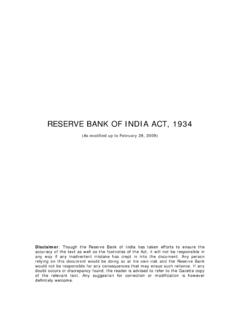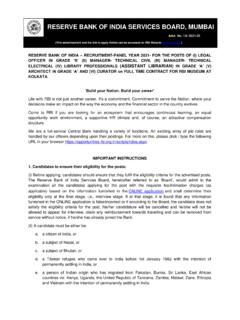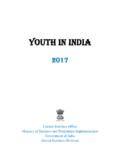Transcription of The design of digital financial infrastructure: lessons ...
1 BIS Papers No 106. The design of digital financial infrastructure: lessons from india by Derryl D'Silva, Zuzana Filkov , Frank Packer and Siddharth Tiwari Monetary and Economic Department December 2019. The views expressed are those of the authors and not necessarily the views of the BIS. This publication is available on the BIS website ( ). bank for International Settlements 2019. All rights reserved. Brief excerpts may be reproduced or translated provided the source is stated. ISSN 1682-7651 (online). ISBN 978-92-9259-324-7 (online). The design of digital financial infrastructure: lessons from india Derryl D'Silva, Zuzana Filkov , Frank Packer and Siddharth Tiwari*. Abstract digital finance has the potential to transform emerging market and advanced economies alike. india 's approach rests on the principle of providing digital financial infrastructure as a public good. It offers an important case study where the results are relevant and applicable for all economies, irrespective of their stage of development.
2 The provision of a national digital biometric identity to all residents has effectively granted them broad access to the banking system. The development of a real-time payment system platform has brought efficiencies to retail customers and small-scale transactions. By providing cheap and instantaneous payment services to ordinary citizens, the design of the Indian payment system challenges the business case for standalone private payment systems. The establishment of a legal framework for data fiduciaries promises to ensure that individuals can readily access the data generated by their online activity and dictate the circumstances for sharing those data. Keywords: digital finance, financial inclusion, payment system, interoperability, data privacy, india Stack. JEL classification: G28, H41, L15, L17, O33. Acknowledgements We are grateful to Agust n Carstens for suggesting this topic. The substance of the paper arose from a conversation in Nandan Nilekani's office in Bangalore.
3 We are grateful to Tanuj Bhojwani, Sanjay Jain, and Sharad Sharma (iSPIRT) and Rohit Das and Karan Javaji (Reserve bank of india ) for extensive collaboration over the course of the project. We are also grateful to Raphael Auer, Fr d ric Boissay, Stijn Claessens, Jon Frost, Leonardo Gambacorta, Stefan Ingves, Sanjeev Mehra, and Tara Rice for comments on earlier drafts. We thank Jenny Hung for providing excellent support throughout the project and Margaret Siu for assisting with document preparation. Responsibility for any errors in the paper remains our own. *. bank for International Settlements. BIS Papers 106 i Contents 1. Introduction .. 1. 2. The challenges .. 3. a. The challenge then: inclusion through identity .. 3. b. The challenge now: improving payment services within the formal financial 5. c. The challenge going forward: data empowerment with consent .. 5. 3. What is a technology stack? .. 6. 4. india Stack .. 7. 5. digital financial infrastructure.
4 10. Rail 1: Identity .. 10. a. Unique identity .. 10. b. Expansion and impact on financial inclusion .. 12. c. Electronic KYC (e-KYC) .. 13. d. Other applications .. 14. Rail 2: Payment 15. a. Initial conditions .. 15. b. Unified Payments Interface (UPI) .. 16. c. Expansion and impact .. 18. d. Challenges from the private 20. Rail 3: Data-sharing .. 22. 6. Conclusions .. 25. 7. References .. 28. BIS Papers 106 iii 1. Introduction Access to finance for individuals is critical for tapping the full potential of an economy. There have traditionally been significant barriers to financial inclusion in most economies emanating from societal attitudes, legal frameworks and prohibitively high transaction costs. Recent evidence has shown that digital technologies offer a powerful way to overcome these barriers and boost access to the banking and financial system. Key features of digital finance include the ability to use mobile devices, quickly authenticate identity, and real-time payment services.
5 Their scalability means that they can be applied to hundreds of millions of customers, even for low-value transactions. Such low-cost, high-volume, low-value digital financial transactions were unimaginable just a decade ago. Much has already been achieved: in india alone, nearly half a billion adults opened bank accounts between 2011 and 2017. In spite of these advances in digital technologies, some billion people today still remain unbanked, with virtually all unbanked individuals living in developing economies. Women remain overrepresented amongst the unbanked globally at about 1 billion, as well as individually in each economy. Globally, about half of unbanked individuals come from the poorest 40% of households and the unbanked are disproportionately The current system penalises those who can afford it the least. Doing nothing is not an option. Increasing access to finance first involves the challenge of bringing the population into the country's formal financial system.
6 Entrepreneurship, investment and economic growth suffer when savings are held, credit granted and payments settled outside the formal system to the benefit of usurious middlemen. But another challenge is to retain individuals in the formal financial system through constant innovation and satisfactory performance. In both cases, the digital financial infrastructure can be designed and implemented so that the large gaps in financial inclusion narrow between genders, as well as between income levels, education and degrees of urbanisation. india offers an example of how various policy reforms related to digital finance . including transformation of the traditional banking system with the central bank playing a pivotal role can solve many of the challenges of inclusive financial development that once seemed out of reach. It also offers insights into how the regulator (eg the central bank ) and the regulated (eg commercial banks) can together run a payment system that operates around the clock throughout the year, is open to the participation of firms ranging from boutique fintechs to big techs and provides all the network benefits that big tech systems usually provide, but settles instantly in fiat money inside the central india 's approach is built upon four pillars: (i) providing digital financial infrastructure as a public good; (ii) encouraging private innovation by providing open access to this infrastructure; (iii) creating a level playing 2.
7 The four largest developing economies with unbanked individuals are: China (224 million), india (191. million), Pakistan (99 million) and Indonesia (97 million). There are 980 million women globally without a bank account, of whom 132 million are in China, 109 million in india , 56 million in Pakistan and 47 million in Indonesia. 30% of unbanked adults are between 15 and 24 years old. See Demirg - Kunt et al (2018) and World bank (2018). 3. By fiat money, we mean state-issued money, declared by the sovereign government to be legal tender. BIS Papers 106 1. field through the regulatory framework; and (iv) empowering individuals through a data-sharing framework that requires their consent. india offers important lessons that are equally relevant for both advanced economies and emerging market and developing economies. In the 10 years since 2009 when the Aadhaar programme, the world's first initiative to provide biometric identity, was launched for all Indians india has created several innovative digital platforms, built as public goods.
8 Each platform, designed within the regulatory system, solves a single need such as identity, payments or data sharing. But when put together, these platforms, which we sometimes refer to as rails in this paper due to their ability to connect different parties, create a powerful stack of applications. The stack reinforces private sector innovation in fintech by supporting open, free and contestable markets in digital finance. By embracing the stack approach, the official sector, in turn, has created a payment system characterised first and foremost by For instance, the identity rail has not only greatly increased financial inclusion, but Aadhaar-based KYC procedures also offer more robust anti-money laundering (AML) / combating the financing of terrorism (CFT) checks to the banking system than before. The payment rails handle instantaneous and seamless financial service transactions for more citizens than before, in fiat money and settling within the banking system.
9 They also route some government payments and can be accessed by private fintech firms. Similar to other forms of digital infrastructure, the india Stack is also making Indians data rich. Data-sharing rails are designed to prevent data capture by the state or the private sector, instead empowering consumers and businesses to benefit from their own data. In this digital financial infrastructure, consumers by controlling the access to and management of their own data can transact in the marketplace without compromising privacy. At the same time, convenient means of sharing data where necessary are incorporated in the infrastructure. Easier access to data, granted with consumer consent, ultimately means that it is cheaper for consumers to find alternative products and services by fostering more competition to provide them. A key feature of this framework is that it dramatically changes the dynamic between regulators and innovators. It enables a type of collaboration between the public and private sectors that harnesses the rapid force of private innovation while protecting the economy (and consumers) through the traditional guardrails of regulation.
10 Notably, the Indian example has established that central banks can be proactive and equal partners with private sector counterparts when it comes to fostering technological innovation in the financial sphere. The strengths of the framework aside, the cyber security risks of any system of digital financial platforms are immense. These include identity and data theft, scope for unlawful violations of privacy and so on. In particular, the risks that identification schemes and system integrity face from hackers must be monitored vigilantly. Likewise, the state's ability to access identification for profiling and access to private details should be carefully circumscribed. 4. Interoperability the technical or legal compatibility that enables a system or mechanism to be used in conjunction with other systems or mechanisms allows participants in different systems to conduct, clear and settle payments or financial transactions across systems without participating in multiple systems.
















